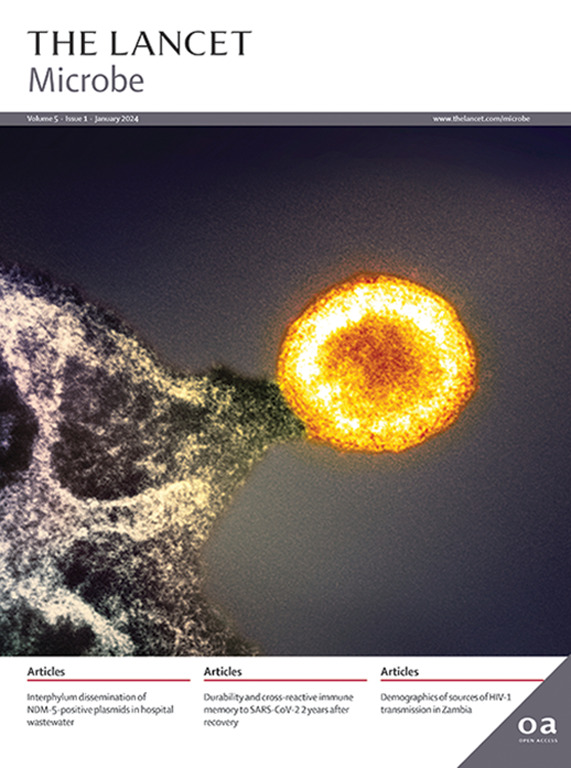蒿甲醚-氨苯曲林-阿莫地喹或青蒿琥酯-阿莫地喹联合单次低剂量伯氨喹减少马里ousamlessacimadbougou地区恶性疟原虫疟疾传播:一项5组、2期、单盲、随机对照试验。
IF 20.9
1区 生物学
Q1 INFECTIOUS DISEASES
引用次数: 0
摘要
背景:以青蒿素为基础的三联疗法(TACTs)可以延缓抗疟药耐药性的传播。青蒿琥酯-阿莫地喹广泛用于治疗无并发症的恶性疟原虫疟疾。因此,我们的目的是确定蒿甲醚-氨芳啶-阿莫地喹和青蒿琥酯-阿莫地喹加或不加单一低剂量伯氨喹对减少配子体携带和传播给蚊子的安全性和有效性。方法:我们在马里巴马科科学、技术和技术大学疟疾研究和培训中心的ousamlessbougou临床研究部进行了一项五臂、单盲、2期随机对照试验。符合条件的参与者年龄在10-50岁之间,显微镜下检测到配子细胞携带无症状的恶性疟原虫。符合条件的参与者被随机分配(1:1:1:1:1)接受蒿甲醚-甲苯胺、蒿甲醚-甲苯胺-阿莫地喹、蒿甲醚-甲苯胺-阿莫地喹加伯氨喹、青蒿琥酯-阿莫地喹或蒿甲酯-阿莫地喹加伯氨喹。治疗方案分别在第0、1、2天实施;伯氨喹在第0天单剂量给药。除试验药剂师和参与者外,所有工作人员都不知道治疗分配。主要观察指标为治疗前和治疗开始后2天蚊虫感染率变化的中位数百分比,采用直接膜饲养法评估。使用每个协议分析来分析数据。本研究已在ClinicalTrials.gov注册,编号NCT05550909。研究结果:在2022年10月16日至2022年12月28日期间,共筛查了1249人;其中100人被招募并随机分配到5个治疗组(每组20人)。治疗前,100名参与者中61人(61%)被蚊子感染,中位数为7.3% (IQR为3.2 ~ 23.5%)。在感染参与者中,蒿甲醚-甲苯胺-阿莫地喹(p= 0.0018)、蒿甲醚-甲苯胺-阿莫地喹(p= 0.0018)和蒿甲醚-甲苯胺-阿莫地喹加伯氨喹(p= 0.009)治疗组的蚊子感染率在治疗前和治疗后2天的中位数百分比降低为100% (IQR 100 ~ 100)。在青蒿琥酯-阿莫地喹组中,蚊子感染率下降的中位数百分比仅为32% (IQR -10·9 ~ 79·4;p= 0.19),而在青蒿琥酯-阿莫地喹+伯氨喹组中位值降低100% (IQR 100 ~ 100;p = 0·0009)。在第2天,20名受试者中有2人(10%)感染了任意数量的蚊子,19名受试者中有2人(11%)感染了青蒿琥酯-阿莫地喹组,20名受试者中有15人(75%)感染了任意数量的蚊子,而在这个时间点上,布氨喹组没有观察到受感染的蚊子。100名参与者中有85人(85%)在随访期间共发生262起不良事件;其中,181例(69%)为轻度,81例(31%)为中度。无严重不良事件报告。解释:我们的研究结果支持蒿甲醚-氨苯曲明单独或作为TACT的一部分在48小时内预防几乎所有人-蚊子疟疾寄生虫传播的有效性。相比之下,用青蒿琥酯-阿莫地喹治疗后观察到大量传播。添加单次低剂量的伯氨喹可迅速阻断蚊虫传播,无论是否使用裂裂剂。资助:比尔及梅琳达·盖茨基金会。本文章由计算机程序翻译,如有差异,请以英文原文为准。
Artemether–lumefantrine–amodiaquine or artesunate–amodiaquine combined with single low-dose primaquine to reduce Plasmodium falciparum malaria transmission in Ouélessébougou, Mali: a five-arm, phase 2, single-blind, randomised controlled trial
Background
Triple artemisinin-based combination therapies (TACTs) can delay the spread of antimalarial drug resistance. Artesunate–amodiaquine is widely used for uncomplicated Plasmodium falciparum malaria. We therefore aimed to determine the safety and efficacy of artemether–lumefantrine–amodiaquine and artesunate–amodiaquine with and without single low-dose primaquine for reducing gametocyte carriage and transmission to mosquitoes.
Methods
We did a five-arm, single-blind, phase 2 randomised controlled trial at the Ouélessébougou Clinical Research Unit of the Malaria Research and Training Centre of the University of Sciences, Techniques and Technologies of Bamako in Mali. Eligible participants were aged 10–50 years, with asymptomatic P falciparum microscopy-detected gametocyte carriage. Eligible participants were randomly allocated (1:1:1:1:1) to receive either artemether–lumefantrine, artemether–lumefantrine–amodiaquine, artemether–lumefantrine–amodiaquine plus primaquine, artesunate–amodiaquine, or artesunate–amodiaquine plus primaquine. Treatment regimens were administered on days 0, 1, and 2; primaquine was given as a single dose on day 0. All staff except the trial pharmacist and participants were masked to the treatment allocation. The primary outcome was the median percentage change in mosquito infection rate between pretreatment and 2 days after treatment initiation, assessed by direct membrane feeding assay. Data were analysed using a per-protocol analysis. This study is registered with ClinicalTrials.gov, NCT05550909.
Findings
Between Oct 16, 2022, and Dec 28, 2022, a total of 1249 individuals were screened; of whom, 100 were enrolled and randomly assigned to one of the five treatment groups (20 per group). Before treatment, 61 (61%) of 100 participants were infectious to mosquitoes, with a median of 7·3% (IQR 3·2 to 23·5) of mosquitoes becoming infected. Among infectious participants, the median percentage reduction in mosquito infection rate between pretreatment and 2 days after treatment was 100% (IQR 100 to 100) in the artemether–lumefantrine (p=0·0018), artemether–lumefantrine–amodiaquine (p=0·0018), and artemether–lumefantrine–amodiaquine plus primaquine (p=0·0009) treatment groups. In the artesunate–amodiaquine group the median percentage reduction in mosquito infection rate was only 32% (IQR –10·9 to 79·4; p=0·19), whereas a 100% median reduction was seen in the artesunate–amodiaquine plus primaquine group (IQR 100 to 100; p=0·0009). At day 2, two (10%) of 20 participants in the artemether–lumefantrine group, two (11%) of 19 in the artemether–lumefantrine–amodiaquine group, and 15 (75%) of 20 in the artesunate–amodiaquine group infected any number of mosquitoes whereas no infected mosquitoes were observed at this timepoint in the groups with primaquine. 85 (85%) of 100 participants had a total of 262 adverse events during follow-up; of which, 181 (69%) were categorised as mild and 81 (31%) as moderate. No serious adverse events were reported.
Interpretation
Our findings support the effectiveness of artemether–lumefantrine alone or as part of TACT for preventing nearly all human–mosquito malaria parasite transmission within 48 h. By contrast, substantial transmission was observed following treatment with artesunate–amodiaquine. The addition of a single low dose of primaquine blocks transmission to mosquitoes rapidly regardless of schizonticide.
Funding
Bill & Melinda Gates Foundation.
求助全文
通过发布文献求助,成功后即可免费获取论文全文。
去求助
来源期刊

Lancet Microbe
Multiple-
CiteScore
27.20
自引率
0.80%
发文量
278
审稿时长
6 weeks
期刊介绍:
The Lancet Microbe is a gold open access journal committed to publishing content relevant to clinical microbiologists worldwide, with a focus on studies that advance clinical understanding, challenge the status quo, and advocate change in health policy.
 求助内容:
求助内容: 应助结果提醒方式:
应助结果提醒方式:


